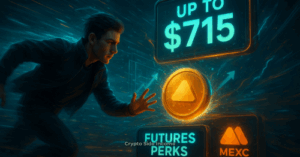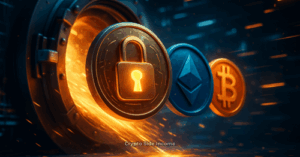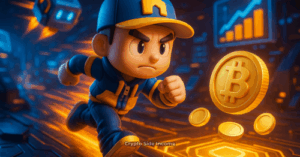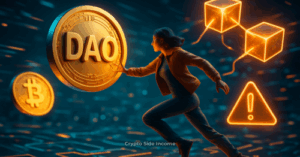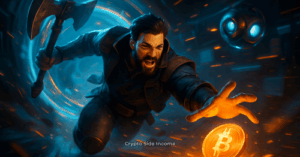
NFT Deep Dive: Explore the transformative world of Non-Fungible Tokens (NFTs)from their core structure to real-world use cases. This in-depth guide demystifies the technology, art, utility, and legal considerations behind NFTs, while offering practical tips for beginners and creators alike.
Understanding the Foundation
To grasp the power of NFTs, it’s essential to understand their core structure and purpose. This section breaks down what NFTs are, how they work under the hood, and why they’re unique. From the underlying technology and metadata to the most iconic collections and legal considerations around ownership, you’ll get a solid grounding in the fundamentals of Non-Fungible Tokens.
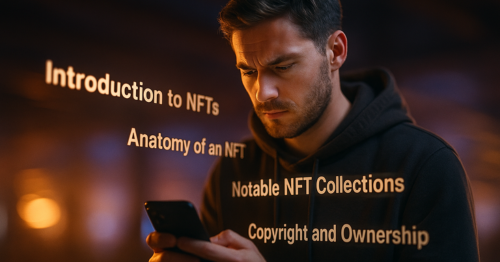
Introduction to NFTs
NFTs, or Non-Fungible Tokens, are unique digital assets that live on a blockchain, a decentralized, tamper-proof ledger. Unlike fungible digital assets like Bitcoin (BTC) or Ethereum (ETH), which can be exchanged on a one-to-one basis, every NFT is a distinct, non-interchangeable digital item with unique attributes.
NFTs surged into the spotlight during 2020 and 2021, driven by the booming popularity of digital art and virtual collectibles. NFTs have since extended their utility beyond just art, infiltrating sectors like music, gaming, real estate, identity verification, and event ticketing.
At their core, NFTs represent ownership and authenticity. Purchasing an NFT grants the buyer a blockchain-based token that serves as verifiable proof of ownership for a specific digital asset. This item can be an image, audio file, video, domain name, or even a virtual plot of land. Thanks to blockchain’s transparency and immutability, the ownership history and metadata of NFTs can be verified and tracked by anyone.
NFTs are most commonly created using Ethereum’s ERC-721 or ERC-1155 token standards, but they also exist on blockchains like Solana, Polygon, Tezos, and even Bitcoin (via Ordinals).
Anatomy of an NFT
To fully understand how NFTs work, it’s essential to explore their underlying structure. Here are the core components that make up a typical NFT:
- Token ID & Contract Address: Each NFT is assigned a unique Token ID, which is tied to a smart contract address. This combination guarantees its uniqueness and authenticity for security purposes.
- Smart Contract: Smart Contracts define the rules of interaction, such as ownership rights, royalties, and transfer permissions. They are automatically executed code that resides on the blockchain.
- Metadata: This refers to the descriptive data attached to the NFT, including the title, creator, attributes (like traits in a character), and links to the asset. NFT metadata may reside on-chain, embedded within the blockchain itself, or off-chain, stored through decentralized platforms like IPFS, Arweave, and others.
- Digital Asset Link: The media file (JPEG, MP4, 3D file, etc.) associated with the NFT is typically hosted off-chain. The metadata includes a pointer (URI or URL) to access this file.
- Creator and Royalty Info: Some NFTs include information about the original creator and built-in royalty payments (e.g., 5%-10% on every resale), enabling artists to earn passive income.
This architecture allows NFTs to be independently verified, scarce, programmable, and transferable.
Notable NFT Collections
The NFT boom introduced several flagship projects that have become cultural touchstones:
- CryptoPunks (Larva Labs): Launched in 2017, CryptoPunks consist of 10,000 uniquely generated 24×24 pixel avatars created through algorithmic design. Being among the earliest NFT collections launched on Ethereum, they’re considered digital artifacts, with some fetching prices in the millions.
- Bored Ape Yacht Club (Yuga Labs): Launched in 2021, BAYC offers 10,000 cartoon apes, each with distinct features. Ownership grants access to exclusive clubs, events, and even real-world benefits. Celebrities and brands flocked to the collection, enhancing its value.
- Art Blocks: A platform for generative art, Art Blocks allows artists to create algorithm-based artwork that is minted on demand by collectors. Projects like “Chromie Squiggles” and “Fidenza” became iconic.
- NBA Top Shot (Dapper Labs): Leveraging the Flow blockchain, NBA Top Shot offers officially licensed highlight clips as tradable NFTs. Its success helped mainstream NFTs among sports fans and collectors.
- Otherdeed for Otherside: A metaverse land NFT collection tied to the BAYC ecosystem, showcasing the evolution of NFTs from collectibles to dynamic 3D environments.
These projects highlight the diversity, creative potential, and speculative interest within the NFT space.
Copyright and Ownership
Ownership is one of the most commonly misunderstood elements of NFTs. When you purchase an NFT, you’re acquiring a token that certifies ownership of a digital item, but this doesn’t automatically grant you rights to replicate, license, or profit from the content commercially.
Here are key distinctions:
- Token Ownership vs. IP Rights: The blockchain certifies you own the NFT token, but intellectual property (IP) rights remain with the original creator, unless explicitly transferred.
- Usage Rights: Some collections, like CryptoPunks (initially), restrict commercial use, while others like BAYC allow full commercial exploitation of your ape, including merchandise, branding, and collaborations.
- Licensing Models: New standards and models such as CC0 (Creative Commons Zero) grant public domain rights, allowing anyone to reuse or remix the content. In contrast, ERC-721C embeds licensing terms directly within the smart contract, enabling on-chain enforcement of usage rights.
- Legal Gray Areas: NFT copyrights are still evolving legally. Jurisdictional differences, vague smart contracts, and off-chain data storage all add complexity to enforcement and clarity.
As a best practice, always review the terms of use, license, and smart contract details before minting, buying, or reselling an NFT.
NFT Creation & Participation
The rise of NFTs has empowered digital creators, collectors, and developers to interact with blockchain-based assets in groundbreaking ways. Whether you’re an artist, entrepreneur, or crypto enthusiast, getting involved in NFTs starts with understanding the process from setup to sale. This section breaks down how to enter the NFT ecosystem, how to create and mint NFTs, and how to buy and sell them securely.
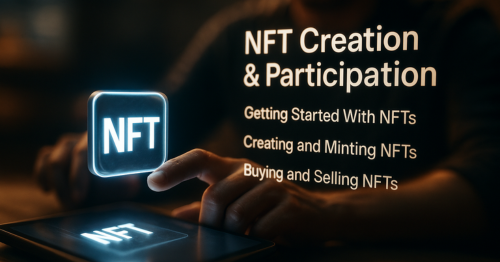
Getting Started With NFTs
Before diving into NFT creation or trading, you need a few essential tools and a basic understanding of how the ecosystem works.
1. Set Up a Crypto Wallet
A crypto wallet secures your digital assets and serves as your gateway to accessing and interacting with NFT marketplaces. Popular options include:
- MetaMask (Ethereum, Polygon)
- Phantom (Solana)
- Trust Wallet (multi-chain)
- Coinbase Wallet (user-friendly for beginners)
These wallets allow you to hold cryptocurrencies (like ETH or SOL), interact with dApps (decentralized apps), and manage NFT assets. Use a strong password to secure your wallet, and store your Seed Phrase offline in a safe place to ensure maximum protection.
Read All About: Top 3 NFT Marketplace Apps And Crypto Wallet
2. Add Cryptocurrency
To mint, buy, or sell NFTs, you’ll need cryptocurrency to pay for network transaction fees (gas fees). For example:
- Use ETH for Ethereum-based NFTs.
- Use MATIC for Polygon-based NFTs.
- Use SOL for Solana-based NFTs.
Cryptocurrency can be purchased from exchanges like Coinbase, Binance, or WazirX, and then transferred to your wallet.
3. Choose an NFT Marketplace
Each blockchain has its own marketplace ecosystem:
- Ethereum: OpenSea, Blur, Foundation, SuperRare
- Polygon: OpenSea, Rarible, Zora
- Solana: Magic Eden, Solanart
- Tezos: objkt.com, fxhash
Explore various platforms, verify legitimacy, and check for marketplace fees before you begin trading or minting.
Creating and Minting NFTs
NFT creation has become accessible to all, thanks to user-friendly no-code platforms. Here’s how to create and mint an NFT step-by-step.
1. Prepare Your Digital Asset
An NFT can represent any digital content, such as:
- Artwork (JPEG, PNG, GIF)
- Music (MP3, WAV)
- Video (MP4, MOV)
- 3D models or AR/VR files
Ensure your file is of high quality and within marketplace upload limits. Some platforms offer support for collections (multiple NFTs minted at once).
2. Choose a Minting Platform
Minting refers to uploading your digital file to a blockchain and creating a token that proves its uniqueness and ownership. Top platforms include:
- OpenSea: Simplified minting with options to create collections and add unlockable content.
- Zora: Creator-friendly, permissionless minting.
- Manifold Studio: Preferred by professional artists for custom contract control.
- Rarible: Supports multi-chain minting (Ethereum, Tezos, Polygon).
Each platform has its own minting fee structure. Some charge upfront, while others support lazy minting (where the buyer pays the gas fee when purchasing).
3. Add Metadata & Configure Settings
You’ll need to add:
- Title & Description
- External Link (e.g., website or portfolio)
- Attributes (e.g., color, rarity, type)
- Royalties (usually 5–10% on secondary sales)
Optional settings include unlockable content (like a download link or exclusive message) and collection grouping.
4. Confirm and Mint
Once all details are filled, connect your wallet and approve the transaction. Once confirmed, your NFT is permanently minted and recorded on the blockchain for public visibility.
Remember, minting on high-traffic blockchains like Ethereum can be costly during peak times. Consider using alternatives like Polygon or Arbitrum for lower fees.
Buying and Selling NFTs
NFT marketplaces work similarly to eCommerce platforms but rely on smart contracts and crypto payments. Here’s how to participate in the trading economy:
1. Buying NFTs
To buy an NFT, follow these steps:
- Connect Your Wallet to a verified marketplace.
- Browse Collections: Filter by trending, price, rarity, or creator.
- Check Key Details:
- Floor Price: The lowest listed price in a collection.
- Ownership History: Verify authenticity via blockchain records.
- Creator Verification: Look for verified badges or social proof.
After selecting an NFT, click “Buy Now” or place a bid if it’s an auction. You’ll be prompted to approve the transaction using your wallet.
Note: Always triple-check the collection’s contract address to avoid purchasing counterfeit NFTs.
2. Selling NFTs
You can sell your NFT either at a fixed price or through an auction-style listing. Here’s how:
- List for Sale: To list your NFT for sale, go to your wallet or marketplace profile, select the NFT, and click on the ‘Sell’ option.
- Set Price: Set your preferred sale method by entering a fixed price or launching an auction with a minimum reserve and time limit.
- Choose Blockchain & Market Options: Some platforms allow cross-listing across chains.
- Pay Listing Fee (if applicable): Cover the listing fee, if required, certain platforms may apply a small charge for listing or removing your NFT.
Smart contracts automatically distribute royalties if configured during minting. Once sold, your crypto will appear in your wallet after gas fees are deducted.
3. Secondary Market Strategies
Successful NFT traders use these strategies:
- Buy Rare Traits: NFTs with low-frequency traits often appreciate in value.
- Flip at Hype Cycles: Timing sales around big announcements or roadmap milestones.
- Hold Blue Chips: Established collections like BAYC or Pudgy Penguins tend to retain value better than lesser-known projects.
Always track market sentiment, community strength, and developer updates when making investment decisions.
Real-World Applications and Concerns
As NFTs continue to evolve beyond their initial hype cycle, the landscape reveals both exciting innovations and notable challenges. In this section, we explore how NFTs are being used across industries, the emergence of Bitcoin-based NFTs (Inscriptions), and the limitations that must be addressed for long-term adoption.

NFT Use Cases
Although digital art played a key role in popularizing NFTs, their applications extend well beyond just visual collectibles. Today, NFTs are being integrated across industries to establish ownership, access, interoperability, and value creation.
Gaming and Virtual Assets
NFTs are revolutionizing the gaming industry by offering players true ownership of in-game assets like:
- Skins
- Weapons
- Virtual land
- Playable characters
Games such as Axie Infinity, The Sandbox, and Illuvium have introduced play-to-earn (P2E) models, allowing players to earn tokens and NFTs with real-world value. These assets can be traded, sold, or even used across different game environments thanks to blockchain interoperability.
Event Tickets and Membership Passes
NFTs are being used as verifiable digital tickets for concerts, conferences, and exclusive experiences. Benefits include:
- Reduced fraud
- Immutable ownership records
- Integration with perks like backstage passes or merchandise drops
Platforms like Tokenproof and YellowHeart are leading this shift in digital ticketing.
Music and Royalties
Artists are using NFTs to distribute music directly to fans, often embedding royalty splits in smart contracts. Notable musicians like Kings of Leon and Snoop Dogg have released albums or exclusives as NFTs, allowing fans to own limited editions while creators earn ongoing royalties from secondary sales.
Identity and Certification
NFTs are finding growing utility in areas like digital identity, educational credentials, and verified certifications. Platforms like Certhis and Blockcerts issue verifiable diplomas or badges that employers or institutions can easily authenticate on-chain.
Real Estate and Tokenized Assets
NFTs are increasingly being leveraged to tokenize real-world assets, bridging physical and digital ownership. In real estate, for example, NFTs can represent property deeds or fractional ownership of land. Projects like Propy and Lofty AI are pioneering NFT-backed real estate transactions.
Inscriptions & Bitcoin NFTs
Ethereum may have set the stage for NFTs, but Bitcoin has recently entered the conversation with Inscriptions, also known as Bitcoin NFTs or Ordinals.
What Are Inscriptions?
Inscriptions involve embedding metadata (text, images, audio, or even video) directly onto individual satoshis, the smallest units of Bitcoin. Bitcoin NFTs differ from those on Ethereum in that they operate without the use of smart contracts. Instead, they leverage the witness data area of Bitcoin transactions, introduced through SegWit and Taproot upgrades.
Why Are They Gaining Popularity?
- Permanence: The data is stored directly on-chain, making it immutable and censorship-resistant.
- Simplicity: Bitcoin NFTs are less complex than smart contracts, which can be a benefit for purists.
- Scarcity: Bitcoin’s capped supply and long-standing security reputation create perceived value and trust.
Projects like Ordinal Punks, Bitcoin Wizards, and marketplaces like Magic Eden BTC are helping grow this niche ecosystem.
Limitations of Bitcoin NFTs
While novel, Bitcoin NFTs face technical and scaling limitations:
- No built-in royalties
- Limited metadata structuring
- High costs due to block space competition
Still, their emergence signals a broader interest in extending NFT concepts to Bitcoin’s more conservative user base.
Limitations and Challenges
Despite the promise of NFTs, several critical challenges could hinder their widespread adoption if not addressed:
Volatility and Speculation
NFT prices are often driven more by hype than intrinsic value. Sudden market downturns have caused massive losses for speculators. Without strong utility or community, many projects struggle to retain long-term value.
Scams, Fraud, and Fake Projects
From rug pulls to counterfeit collections, the NFT space is rife with malicious activity. Common scams include:
- Fake minting websites
- Phishing links disguised as official announcements
- Duplicate collections on marketplaces
Users must verify collection contract addresses, use official links, and avoid unsolicited DMs in NFT communities.
Environmental Concerns
Ethereum NFTs previously faced criticism for energy use. The Ethereum Merge (2022) transitioned the network to Proof of Stake, reducing energy consumption by over 99.9%. However, some chains and marketplaces still operate on energy-intensive Proof of Work systems.
Legal and Regulatory Gray Areas
The legal landscape for NFTs is still developing:
- Are NFTs considered securities?
- Who holds copyright and IP rights?
- How are royalties enforced across chains?
Governments and regulatory bodies like the SEC are increasingly scrutinizing NFTs, especially when used for financial speculation or fundraising.
Interoperability and Platform Risk
Many NFTs rely on off-chain data storage (e.g., AWS, IPFS). If a project shuts down or metadata links break, the digital file associated with the NFT could become inaccessible. This raises concerns about true ownership and asset permanence.
Conclusion
NFTs have emerged as a transformative force in the digital world, offering new ways to create, own, and exchange value. From understanding their technical foundation to exploring hands-on creation and real-world use cases, it’s clear that NFTs go far beyond digital art. They represent a broader shift toward decentralized ownership and programmable assets.
While the opportunities are vast, spanning gaming, music, identity, and even Bitcoin-native NFTs, challenges like market volatility, scams, copyright confusion, and regulatory uncertainty still need to be addressed. As the technology matures, those who stay informed, cautious, and creative will be best positioned to thrive in this evolving landscape.
NFTs aren’t just a trend, they’re a building block of the next digital era.
Frequently Asked Questions
What is an NFT?
NFT stands for Non‑Fungible Token, a unique digital identifier stored on a blockchain that certifies ownership and authenticity of a digital asset, such as art, music, video, or virtual real estate. Unlike cryptocurrency tokens (e.g., Bitcoin), NFTs are not interchangeable because each one is distinct
How do you create (mint) an NFT?
Creating an NFT involves the following steps:
1. Prepare a digital file (image, audio, video).
2. Choose a blockchain (e.g., Ethereum, Solana, Flow).
3. Set up a compatible crypto wallet (such as MetaMask or Phantom).
4. Upload the file to an NFT platform (e.g., OpenSea, Magic Eden, Rarible).
5. Add metadata (title, description, royalties) and mint, paying required gas or platform fees
Where can you buy and sell NFTs?
NFTs are traded on marketplaces built for specific blockchains. Examples include:
OpenSea, Blur, Foundation (Ethereum, Polygon)
Magic Eden, Solanart (Solana)
NBA Top Shot on Flow
You need a crypto wallet and cryptocurrency to connect to these platforms. Listings can be fixed-price or auction-based
What is the most expensive NFT ever sold?
One of the most expensive NFTs to date is Beeple’s “Everydays: The First 5000 Days”, a digital collage sold by Christie’s for roughly $69 million in 2021. Collections like CryptoPunks and Bored Ape Yacht Club also rank among the highest-value NFT projects
Why are NFTs valuable?
NFT value is derived from factors such as rarity, provenance, creator reputation, and community demand. Digital scarcity, verifiable ownership, and built-in royalties make NFTs attractive to collectors, investors, and brands, and some NFTs offer access to exclusive communities or experiences

